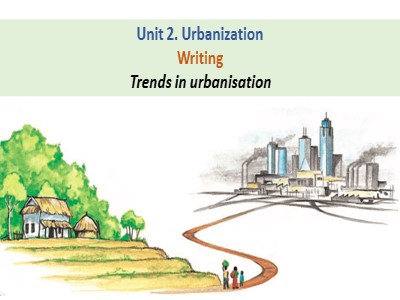Bài giảng English 12 - Unit 2: Urbanisation. Lesson 6: Writing

1. The migration of young people to big cities has risen dramatically.
→ There
2. Due to shortages of jobs, there has been a decrease in the population in rural areas in the last 10 years.
→ Due to shortages of jobs, the population
3. The urbanisation rate in Indonesia increased by over 30% from 1969 to 2009.
→ There
4. There was a sharp rise in the rate of urbanisation in South Korea during the period between 1969 and 1989.
→ The rate of urbanization
5. The urbanisation rate in this city decreased slightly during the economic crisis in 2008.
→ There was
Bạn đang xem tài liệu "Bài giảng English 12 - Unit 2: Urbanisation. Lesson 6: Writing", để tải tài liệu gốc về máy bạn click vào nút DOWNLOAD ở trên
Unit 2. Urbanization Writing Trends in urbanisation Task 1. Match the phrases in the box with the graphs (a-f) fall/decrease sharply A B C D E F fall/decrease steadily rise/increase steadily rise/increase sharply fluctuate stay the same/ remain stable/ level off A B C D E F rise/increase steadily: tăng dần fall/decrease sharply: giảm mạnh stay the same/ remain stable/ level off: giữ nguyên fluctuate: biến động rise/increase sharply: tăng mạnh fall/decrease steadily: giảm dần Task 1. Match the phrases in the box with the graphs (a-f) A B C D E F rise/increase steadily: tăng dần fall/decrease sharply: giảm mạnh stay the same/ remain stable/ level off: giữ nguyên fluctuate: biến động rise/increase sharply: tăng mạnh fall/decrease steadily: giảm dần C Examples : 1. The number of young people working on farms has decreased sharply over the past years. There has been a sharp decrease in the number of young people working on farms. 2. The number of urban inhabitants rose by 15% from 1990 to 1995. There was a rise of 15% in the number of urban inhabitants from 1990 to 1995. Task 2. Rewrite the sentences without changing their meaning Task 2. Rewrite the sentences without changing their meaning 1. The migration of young people to big cities has risen dramatically. → There 2. Due to shortages of jobs, there has been a decrease in the population in rural areas in the last 10 years. → Due to shortages of jobs, the population 3. The urbanisation rate in Indonesia increased by over 30% from 1969 to 2009. → There 4. There was a sharp rise in the rate of urbanisation in South Korea during the period between 1969 and 1989. → The rate of urbanization 5. The urbanisation rate in this city decreased slightly during the economic crisis in 2008. → There was a slight decrease in the urbanisation rate in this city during the economic crisis in 2008. in South Korea rose sharply during the period between 1969 and 1989. was an increase of over 30% in the urbanisation rate in Indonesia from 1969 to 2009. in rural areas has decreased in the last 10 years. has been a dramatic rise in the migration of young people to big cities. Task 3. The line graph below shows the urbanisation rate in South Korea and Indonesia. Write a description (of about 150 words) of the trends in the graph. Task 3. The line graph below shows the urbanisation rate in South Korea and Indonesia. Write a description (of about 150 words) of the trends in the graph. Tham khảo: The line graph shows the rate of urbanisation in two countries, namely Indonesia and South Korea , from the mid-1960s to 2009. In the mid-1960s, the rate of urbanisation in Indonesia was about 17%, followed by a slight increase of 3% in 1969. Then the rate remained stable at around 20% for a ten-year period from 1969 to 1979. In the next fifteen years, there was a steady rise in the rate of urbanisation in this country. From 1995 to 2009, Indonesia's urbanisation rate increased sharply, reaching over 50%. South Korea's urbanisation rate was about 30% in 1969, roughly 10% higher than that of Indonesia. The rate went up sharply throughout the next thirty-year period to about 82% in 2005 and then leveled off towards 2009. In conclusion, it is clear that while both countries experienced a growth in their urbanisation rate, in South Korea it almost doubled by the end of the period.
Tài liệu đính kèm:
 bai_giang_english_12_unit_2_urbanisation_lesson_6_writing.pptx
bai_giang_english_12_unit_2_urbanisation_lesson_6_writing.pptx



